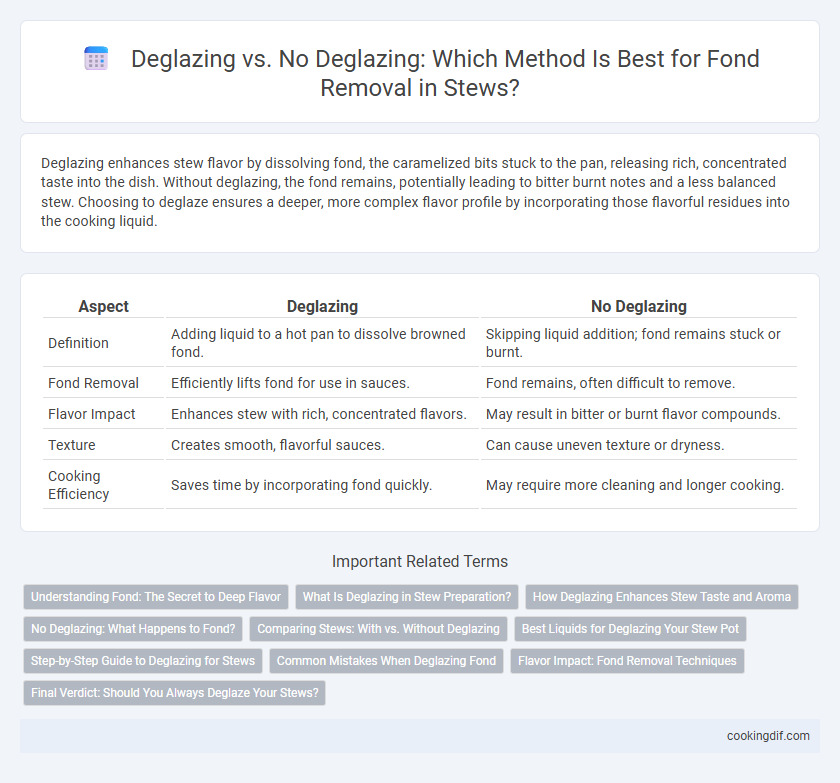Deglazing enhances stew flavor by dissolving fond, the caramelized bits stuck to the pan, releasing rich, concentrated taste into the dish. Without deglazing, the fond remains, potentially leading to bitter burnt notes and a less balanced stew. Choosing to deglaze ensures a deeper, more complex flavor profile by incorporating those flavorful residues into the cooking liquid.
Table of Comparison
| Aspect | Deglazing | No Deglazing |
|---|---|---|
| Definition | Adding liquid to a hot pan to dissolve browned fond. | Skipping liquid addition; fond remains stuck or burnt. |
| Fond Removal | Efficiently lifts fond for use in sauces. | Fond remains, often difficult to remove. |
| Flavor Impact | Enhances stew with rich, concentrated flavors. | May result in bitter or burnt flavor compounds. |
| Texture | Creates smooth, flavorful sauces. | Can cause uneven texture or dryness. |
| Cooking Efficiency | Saves time by incorporating fond quickly. | May require more cleaning and longer cooking. |
Understanding Fond: The Secret to Deep Flavor
Fond, the caramelized bits stuck to the bottom of a pan after searing or sauteing, is essential for building deep, rich flavors in stews. Deglazing involves adding liquid like wine or broth to dissolve these browned particles, incorporating intense savory notes into the cooking liquid. Skipping deglazing leaves the fond stuck and unutilized, resulting in a less flavorful stew with missed depth and complexity.
What Is Deglazing in Stew Preparation?
Deglazing in stew preparation involves adding liquid, such as broth or wine, to a hot pan to dissolve browned food particles, known as fond, stuck to the bottom. This technique enhances the stew's flavor by incorporating the caramelized bits into the sauce, creating a richer and more complex taste profile. Skipping deglazing often results in a less flavorful stew, as the fond remains stuck and its savory essence is lost.
How Deglazing Enhances Stew Taste and Aroma
Deglazing lifts the fond, the caramelized bits stuck to the bottom of the pot, dissolving them into the cooking liquid and intensifying the stew's flavor. This process releases concentrated Maillard reaction compounds that boost umami depth and aromatic complexity. Without deglazing, the stew lacks these enriched savory notes, resulting in a flatter taste profile and less fragrant aroma.
No Deglazing: What Happens to Fond?
When no deglazing occurs, the fond--the caramelized bits stuck to the pan--remains adhered, intensifying the pan's flavor but limiting its incorporation into the dish. Without the addition of liquid to dissolve these browned residues, the fond can become overly concentrated, sometimes leading to bitterness or burnt notes if cooked further. This approach preserves the fond's texture but reduces the potential complexity and moisture that deglazing typically introduces to stews.
Comparing Stews: With vs. Without Deglazing
Deglazing a stew involves adding liquid, such as wine or broth, to the hot pot after browning meat, effectively loosening and dissolving the fond--the caramelized bits stuck to the pan--that enriches the stew's depth of flavor. Stews prepared without deglazing often lack this intensified umami complexity, resulting in a less robust taste profile. Comparing both methods reveals that deglazing enhances fond incorporation, yielding a richer, more savory stew with improved mouthfeel and aromatic layers.
Best Liquids for Deglazing Your Stew Pot
Deglazing a stew pot effectively lifts fond, adding depth and complexity to the stew's flavor. The best liquids for deglazing include robust options like red wine, dry sherry, or beef broth, which complement the rich meatiness of the fond. Alternatively, apple cider vinegar or tomato juice can provide acidic brightness, balancing the stew's savory elements while enhancing fond release.
Step-by-Step Guide to Deglazing for Stews
Deglazing stews involves adding liquid like wine, broth, or water to a hot pan after browning meat, which dissolves the fond--the caramelized bits stuck to the bottom that contain intense flavor. To deglaze, first remove the browned meat, then pour a small amount of liquid into the hot pan and scrape the bottom with a wooden spoon to lift the fond. Incorporating this flavorful liquid back into the stew enhances depth and richness, while skipping deglazing can result in less complex taste and a less smooth sauce.
Common Mistakes When Deglazing Fond
Common mistakes when deglazing fond include using too much liquid, which dilutes the concentrated flavors developed during browning. Another error is adding cold liquid directly to a hot pan, causing uneven fond release and potential splattering. Failing to scrape the fond thoroughly results in leftover caramelized bits that diminish the dish's depth and richness.
Flavor Impact: Fond Removal Techniques
Deglazing enhances flavor by dissolving fond, the caramelized bits left in the pan, into the stew, enriching the broth with deep, complex savory notes. Without deglazing, the fond remains stuck, resulting in a less intense flavor profile and a thinner consistency. Utilizing wine, stock, or vinegar for deglazing extracts maximum umami and caramelization residues, significantly boosting the stew's richness and depth.
Final Verdict: Should You Always Deglaze Your Stews?
Deglazing is essential for unlocking deep, complex flavors by dissolving the fond--the caramelized bits stuck to the pan--into the stew, enriching its taste and aroma. While skipping deglazing may save time, it often results in a less flavorful dish lacking the savory depth that fond provides. For optimal stew quality, always deglaze after browning meat to ensure maximum flavor extraction and a richer, more satisfying final dish.
Deglazing vs no deglazing for fond removal Infographic

 cookingdif.com
cookingdif.com